Click the icon of your choice to get the information of the facility you are interested in and
use the image map to get location information.
Symbols of Gwanghwamun Square
One of the greatest heroes of the Korean nation and the first king of the Joseon dynasty who was enthroned and died at Gyeongbokgung Palace.
A great naval commander and strategist of mid Joseon, Admiral Yi Sun-sin earned great victories at the famous naval battles waged between Joseon and Japan at Okpo, Hansando and Myeongnyang.
Stories about the heroic spirit of, and achievement made by, King Sejong and Admiral Yi Sun-sin
This splash fountain symbolizes the naval battles won by Admiral Yi Sun-sin
Birth of a public square
A square linking daily life and culture
A square more like a park with woods and cool shades
Gwanghwamun Gate seen from the pine wood
A garden reflecting the long history of Seoul
A garden where one can face all the four seasons of Korea
A space where one can store all his or her daily activities
A space where people sea each other and have a rest
Gwanghwamun Square turned into a forest
Waterway linking the past and present
History from the foundation of the Joseon dynasty in 1392 and the present as of 2022
Wall fountain that flows to the depth of history
A space for water play with water springing from the floor
Views of the wood and sky reflected on the surface of water
An arched fountain created by 77 water streaks
Korean alphabets created with water streaks
This splash fountain symbolizes the naval battles won by Admiral Yi Sun-sin
Traces of the Yukjo, or Six Ministries of the government of Joseon
Location: Haechi Lounge
Hours: 9 AM–6 PM (Tue–Sat)
Location: Haechi Lounge
- Hours: 5 AM–1 AM
Sejong-ro Public Parking Lot Restroom (B1)
- Open 24 hours a day, Sejong-ro Park Parking Lot (B1)
Location: Haechi Lounge
Furnished: Sofa, washstand, baby changing station
Location: Haechi Lounge
Furnished: Sofa, table, washstand
Beverage vending machine
- Entrance to Sejong-ro Park Parking Lot
- In front of benches by Hangeul Fountain
- Inside Haechi Lounge
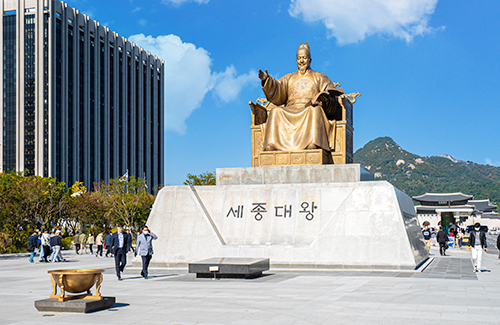
A statue of King Sejong who is generally regarded as one of the greatest heroes of the Korean nation and the first king of the Joseon dynasty who was enthroned and died at Gyeongbokgung Palace. The statue (6.2 m tall and 4.3 m wide on a 4.2 m granite pedestal) features King Sejong seated on a throne facing south. The king, showing a benign face, has in his left hand a copy of the Hunminjeongeum Haeryebon, a book of the Korean writing system he had invented. He has his right hand gently raised up, expressing his wish for the writing system to be widely taught and used among his people. There are in the front of the pedestal carvings of the original text of the Hunminjeongeum and its interpretation together with those of a sundial, rain gauge and armillary sphere that represent the scientific achievement made during his reign. There are behind the statue six stone columns standing in two rows, symbolizing the achievement made by the king.
Established: Oct. 9, 2009
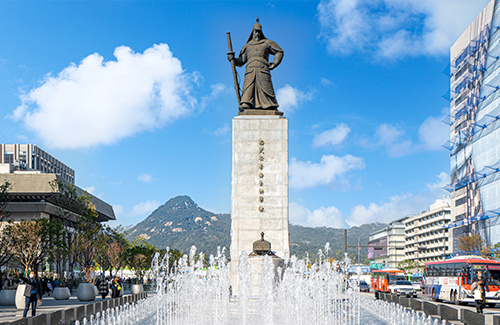
This bronze statue of Admiral Yi Sun-sin, a great naval commander and strategist of mid Joseon who earned great victories at the Battles of Okpo, Hansando and Myeongnyang, is 17 meters in height (including a pedestal which is 10.5 meters in height). There are on the front of the pedestal lying two stone drums and on the pedestal a replica of the turtle-shaped battleship (Geobukseon). There are on both sides of the pedestal scenes of the Battle of Myeongnyang carved in relief. Around the statue of Admiral Yi Sun-sin are Myeongnyang Fountain and the Yi Sun-sin Monument.
Established: Apr. 27, 1968
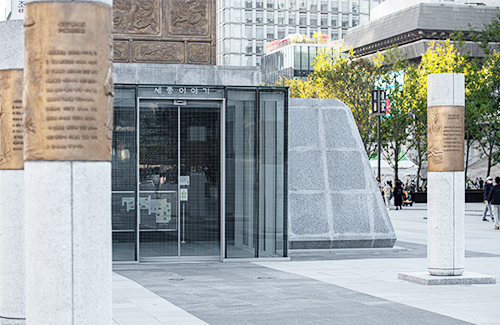
There is on the rear side of the King Sejong’s statue the entrance to the exhibition hall of the King Sejong’s story. Visitors to the exhibitions of the stories of King Sejong and Admiral Yi Sun-sin presented, respectively, at the hall built under the king’s statue using the old underpass and the basement of the Sejong Center building are offered the exciting stories about the lives and achievements made by two of the greatest heroes in Korean history.
The cube-shaped Media Glass installed at the entrance to the underground exhibition hall presents a collection of media art works created by a group of rising artists focusing on the achievements by King Sejong and Admiral Yi Sun-sin and Hangeul-related content.
| Admission | Free |
|---|---|
| Hours | 10 AM–6:30 PM (last admission 6 PM) Closed on Mondays. (Please note that the exhibition hall is open on Monday if it is a public holiday, and closed on the first weekday after the holiday.) |
| Inquiries | Sejong Center for the Performing Arts +82-2-399-1000 |
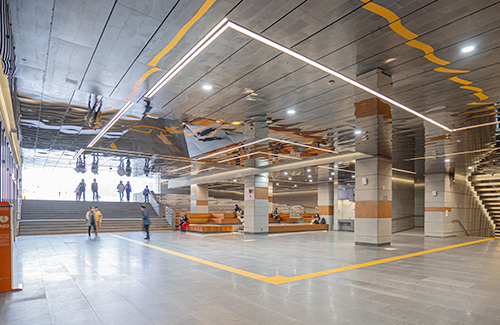
Birth of a public square for all This is Haechi Lounge.
It links Gwanghwamun Station and Gwanghwamun Square, and provides a venue for rest and meetings.
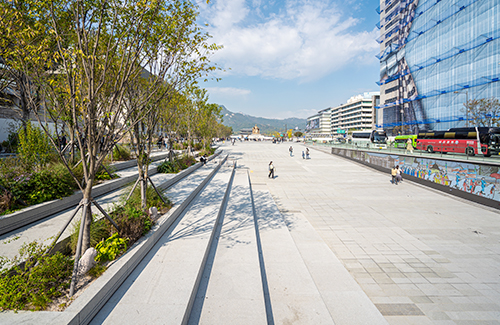
This stepped shelter is built on the ramp linking the interior of Haechi Lounge and Gwanghwamun Square.
Citizens visiting the place can have rest and enjoy videos under a tree shade.
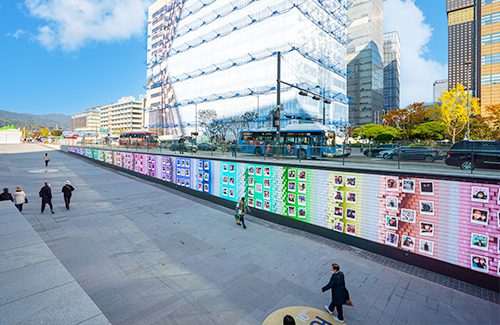
Visitors can enjoy a variety of video works screened on the wall of the Haechi Lounge ramp. The video works presented here are largely focused on the motif of Cheonjiin, or “Heaven, Earth and Humanity,” originated from the King Sejong’s love for his people. Of the works, those dealing with the theme of “human being” (人), such as “Aquarium” and “Poloraid,” are open to the visitors, expecting their participation.

This space linked with Gwanghwamun Gate and Woldae symbolizes Yukjo Geori which contained offices of the key ministries of the government of Joseon. A spacious lawn was created to highlight the scenic beauty of Gwanghwamun Gate. The area around the lawn is paved with stone slabs, forming the traditional checkered floor. It is here at the Yukjo Yard that the History Waterway, consisting of stone slabs inscribed with Korean history from the foundation of the Joseon dynasty in 1392 to the present. Visitors may sit on the benches installed along the History Waterway and smell the fragrance of pine trees growing there, feeling the flow of history.
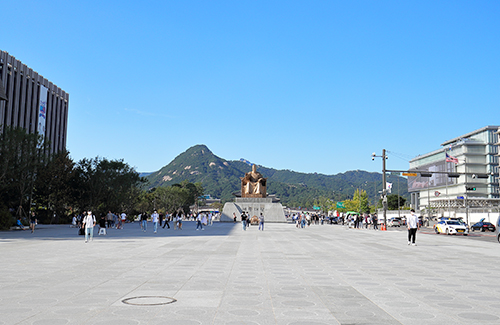
The space between the King Sejong’s statue and the central stairway of Sejong Center provides a venue for various events. On both sides of the event area are benches installed for use by event participants for resting and refreshment.
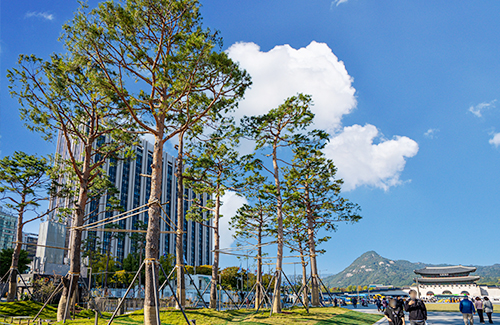
The first space that appears before the visitor after Jandi Yard is Pine Garden which remains green all four seasons. In the garden, pine trees are arranged at the entrance to the square, considering that pine has been loved by men of letters and artists. Here one can have fine views of Gwanghwamun Gate and Bugaksan Mountain seen through tall pine trees.
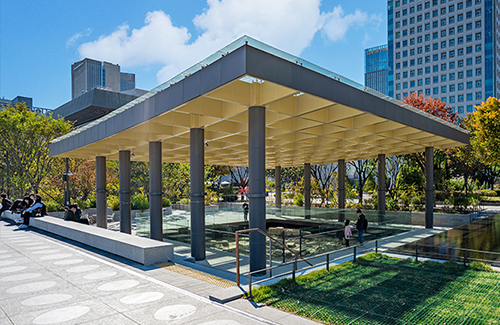
The geological strata, Saheonbu site, drainage and well discovered during the rescue excavation of the site are tangible evidences of the Seoul’s long history
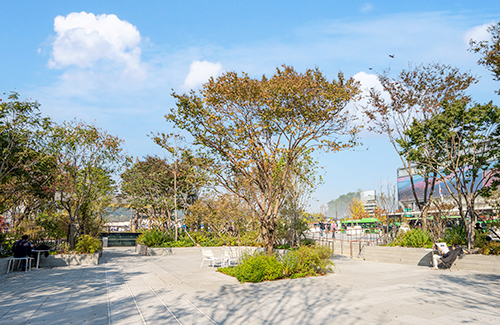
Containing a lot of tree species native to Korea, this garden creates natural views uniquely Korean that change according to the change of four seasons. The flower beds built using long rectangular blocks of hewn stone, showing an inspiration from the “floral steps” in the palace gardens of Joseon, create a cozy, but exuberant, atmosphere.

Located in front of Sejong Center, this garden can store daily activities occurred in the park. The garden contains a lot of oaks, one of the most commonly found tree species in the mountains across Korea, bridging the intimate natural views of Bugaksan Mountain with Gyeongbokgung Palace and Gwanghwamun Square. There is under the trees of Culture Garden the Long Table, a comfortable resting place and “dining table set for all.”

There is in this area a large tree creating a shade for people visiting it to have a rest. There is on the ground a design made by setting stones collected from all corners of Korea in the traditional "jogakbo" (patchwork) pattern.
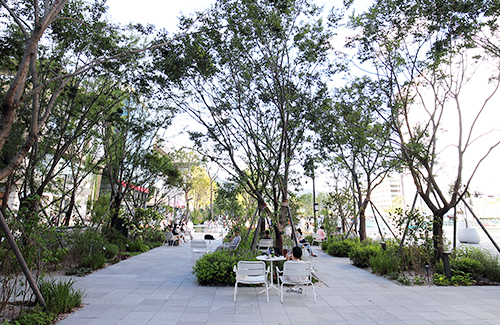
Located just off the busy Sejong-daero intersection, this green space with dense trees provides an attractive resting place. The refreshing green area is created by a fine mixture of the tall trees such as zelkova, elm and Korean hackberry with short trees and shrubs such as bluebird, Korean redbud and Korean weigela and tiny flowering plants.
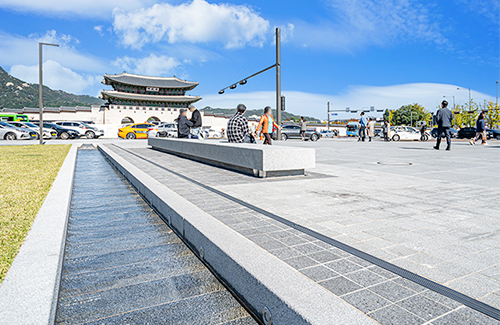
Gwanghwamun Square features a waterway of 630-year history flowing from 1392 when Joseon was founded. History Waterway originates from the Yukjo Yard located in front of the Government Seoul Complex and flows to cross the entire Gwanghwamun Square until reaching its destination at Hangeul Fountain.
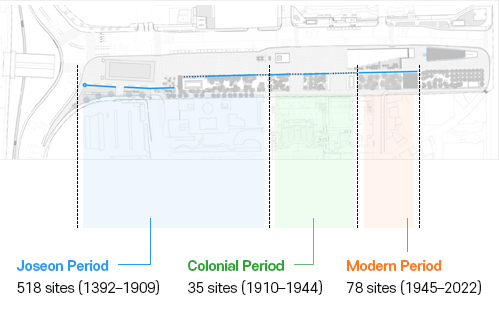
If you walk along the waterway you can travel through the main events in Korean history as inscribed on stone slabs.
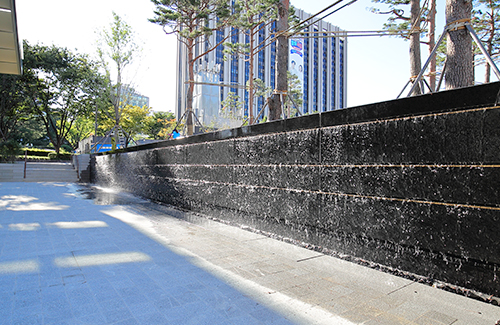
This water feature is designed to use the difference (1.2 m) between the levels of Gwanghwamun Square and the archaeological features to let water fall from the top of the wall, helping viewers feel the flow of time.
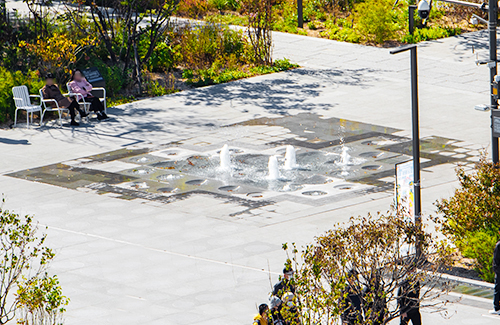
This spring fountain is a wading pool, a children’s playground conceived from the well discovered at the entrance to the Saheonbu site.
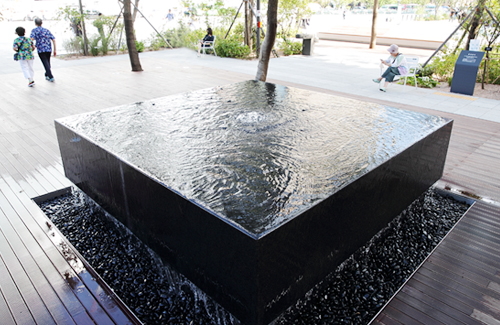
It is a tiny, exquisite basin in the shape of a table where a view of a saw-tooth oak wood and sky is reflected on the surface of water.
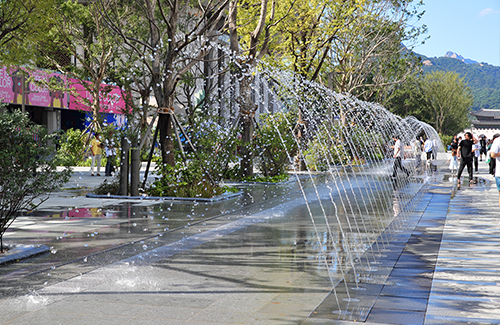
This fountain symbolizes the rapid economic growth and prosperity Korea has been enjoying from its liberation from the Japanese colonial rule in 1945 to the re-opening of Gwanghwamun Square in 2022. There is under the Tunnel Fountain flowing the waterway of the Korean history of 77 years after its liberation from the Japanese colonial rule in 1945.
Do not drink fountain water.
Make sure to wear water shoes.
Do not use the fountain if you feel sick or have a symptom of diarrhea or a contagious skin disease.
Infants must wear swim diapers.
Do not urinate, defecate, or spit in the fountain.
No food and hazardous items (glass object, for example).
No pets allowed.
No running, jumping, or rough play.
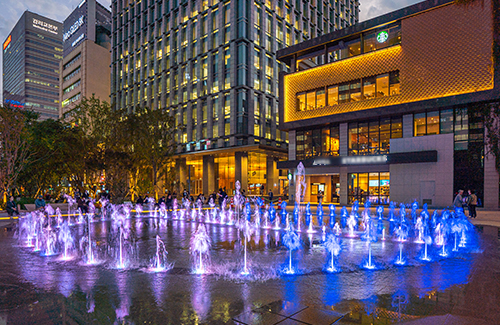
The fountain is designed to create the symbols of the consonants and vowels of the Korean writing system which was created on the basis of the “Heaven, Earth and Humanity” principle. One can guess the Hangeul alphabets expressed by the fountain.
Do not drink fountain water.
Make sure to wear water shoes.
Do not use the fountain if you feel sick or have a symptom of diarrhea or a contagious skin disease.
Infants must wear swim diapers.
Do not urinate, defecate, or spit in the fountain.
No food and hazardous items (glass object, for example).
No pets allowed.
No running, jumping, or rough play.
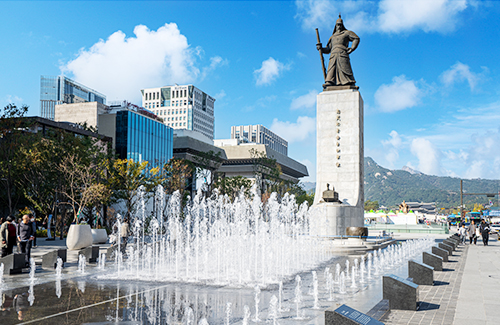
This splash fountain symbolizes the naval battles won by Admiral Yi Sun-sin. The 133 nozzles of the inner fountain represent the 133 Japanese battleships destroyed by the Joseon seamen led by the Admiral while the outer fountain represents the “crane wing formation” (Hagikjin) he used to strike the enemy fleet at the Battle of Hansando. The ground lighting on the front of the fountain is 15.45 meters long, marking the year 1545 when Admiral Yi Sun-sin was born.
Do not drink fountain water.
Make sure to wear water shoes.
Do not use the fountain if you feel sick or have a symptom of diarrhea or a contagious skin disease.
Infants must wear swim diapers.
Do not urinate, defecate, or spit in the fountain.
No food and hazardous items (glass object, for example).
No pets allowed.
No running, jumping, or rough play.

The exhibition of the Saheonbu Gate site has been formed to promote and share the value and meanings of a buried cultural heritage that had been excavated from the area. The location where the exhibition has been formed is where Saheonbu used to be situated. A drain system, well, walls around the building, site of the main gate, and traces of servant rooms were found in the area. The exhibition facility, built roughly 1.2 meters under the ground, features a roof line of the traditional Korean building and columns whose height and thickness are similar to those of the trees growing in the surrounding area. The exhibition facility has a vantage point from which one can enjoy a fine view of Gwanghwamun Gate seen between two columns.
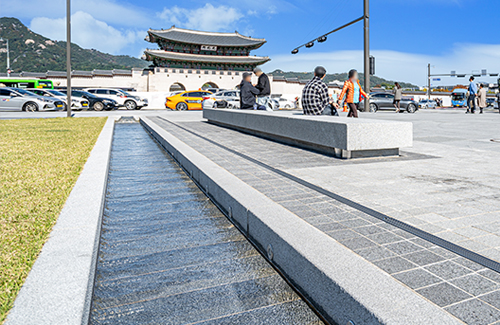
In the Joseon period, the area of the present-day Gwanghwamun Square was occupied by the offices of key government agencies of Joseon. Of the discoveries, structural remains of the well and the gate of Saheonbu were exposed for the public display in situ while all other discoveries were backfilled and marked with above-ground representations designed to contain the traces of the Yukjo.
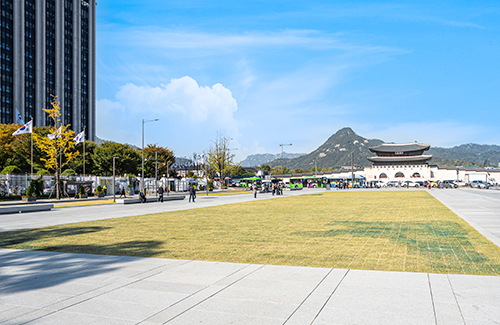
Point 1 at the Yukjo Yard provides a fine view of the pine wood with Gwanghwamun Gate and Bugaksan Mountain combined with the paved ground of Gwanghwamun Square
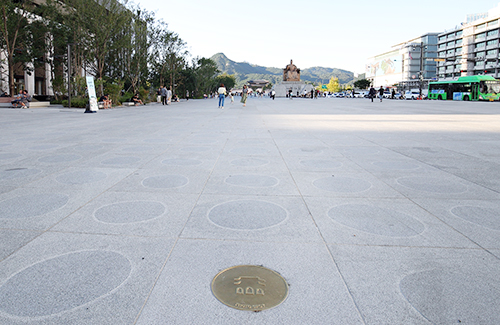
Point 2 at the statue of King Sejong, a landscape of the king’s statue, Gwanghwamun Gate and trees
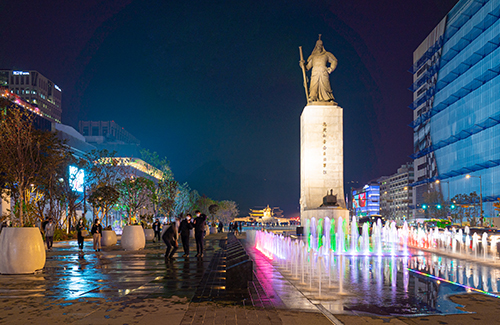
Point 3 at the statue of Admiral Yi Sun-sin, a view of the entire square ranging from Myeongnyang Fountain and the statue of Admiral Yi Sun-sin to Gwanghwamun Gate.
| Honcheonui (armillary sphere) |
Honcheonui, a device used to measure the movement and location of stars in the premodern period, is known to have begun to be made in Korea after the Three Kingdoms Period while the oldest remaining example was made in 1433 by Jang Yeong-sil and Yi Cheon under a royal order from King Sejong. |
|---|---|
| Rain gauge | This rain gauge made in 1441 when Joseon was under the reign of King Sejong is known to be the world’s first of its kind. The early rain gauges feature a cylindrical form measuring 41 cm in depth and 16 cm in diameter, but the figures were changed to 31 cm and 14 cm according to the regulations established in May 1442. The devise is widely considered as one of a few items representing the advanced science and technology achieved in Joseon. |
| Angguilgu (cauldron-shaped sundial) |
The sundial was made by Jang Yeong-sil in 1437, and called "angguilgu" because it has the shape of a cauldron. While there is no example remaining today, the cauldron-shaped sundials made during the reign of King Sejong were installed at Hyejeonggyo Bridge and the Jongmyo Shrine in Seoul, performing as the Korea’s first public clocks telling times for ordinary citizens. |
On May 7, 1592 (lunar calendar date), the Joseon fleet led by Admiral Yi Sun-sin destroyed a total of 26 Japanese vessels in Okpo (Geoje-si, Gyeongsangnam-do). The Joseon naval force made its first victory against Japan in this battle during the Imjin War.
From May 29 to June 1, 1592 (lunar calendar date), the Joseon fleet led by Admiral Yi Sun-sin destroyed a total of 13 Japanese vessels in Sacheon (Sacheon-si, Gyeongsangnam-do). This battle was when Admiral Yi’s “geobukseon” (turtle ship) was first used.
On June 2, 1592 (lunar calendar date), the Joseon fleet led by Admiral Yi Sun-sin destroyed a total of 21 Japanese vessels in Dangpo (Tongyeong-si, Gyeongsangnam-do). The Japanese flagship was destroyed with Admiral Yi’s tactic using the “geobukseon” (turtle ship).
On June 5, 1592 (lunar calendar date), the combined fleet of Joseon destroyed a total of 28 Japanese vessels in Danghangpo (Goseong-gun, Gyeongsangnam-do). Admiral Yi Sun-sin was joined by the regional commander of the Jeolla Right Naval Headquarters, greatly increasing the total number of warships.
On July 8, 1592 (lunar calendar date), the combined fleet of Joseon launched an operation and destroyed a total of 59 Japanese vessels in Hansando (Tongyeong-si, Gyeongsangnam-do). This battle is one of the three main battles of the Imjin War along with the Battle of Haengju and the Siege of Jinju.
On July 10, 1592 (lunar calendar date), the combined fleet of Joseon destroyed over 20 Japanese vessels in Angolpo (Changwon-si, Gyeongsangnam-do). Admiral Yi Sun-sin made use of the geographical feature of Angolpo that had a narrow inlet and had his vessels attack alternately, leading to victory.
On September 1, 1592 (lunar calendar date), the combined fleet of Joseon destroyed over 100 Japanese vessels in Busanpo (Busan Bay, Busan). This battle attacked Busan Bay, the base of the Japanese forces during the Imjin War, resulting in a decisive victory of Joseon.
From February 10 to March 6, 1593 (lunar calendar date), the combined fleet of Joseon combated 7 battles in Ungpo (Changwon-si, Gyeongsangnam-do). This battle taught a lesson that it is necessary to join with the armed forces to annihilate the Japanese navy when the latter avoids battle.
On March 4–5, 1592 (lunar calendar date), the combined fleet of Joseon led by Admiral Yi Sun-sin as Naval Commander of the Three Provinces destroyed 31 Japanese vessels in Danghangpo (Goseong-gun, Gyeongsangnam-do). This battle brought victory with the impeccable tactics of Yi.
On September 16, 1597 (lunar calendar date), Admiral Yi Sun-sin who was reappointed as Naval Commander of the Three Provinces fought against 133 Japanese vessels and destroyed 31 of them with 13 ships in Myeongnyang (a strait between Haenam-gun and Jindo in Jeollanam-do).
On July 19, 1598 (lunar calendar date), the Joseon fleet led by Admiral Yi Sun-sin destroyed 6 Japanese vessels near Jeorido (Goheung-gun, Jeollanam-do). The victory of this battle showed the world that the Joseon navy had revived.
On November 19, 1598 (lunar calendar date), the combined fleets of Admirals Yi Sun-sin and Chen Lin of the Ming Dynasty destroyed 200 Japanese vessels in Noryang (a strait between Hadong-gun and Namhaedo in Gyeongsangnam-do). This was the final battle of the Imjin War, during which Admiral Yi breathed his last.
– Imjin Jangcho (Drafts of Imjin War Reports of Admiral Yi Sun-sin)
Admiral Yi Sun-sin encouraging his generals and soldiers before the Battle of Okpo on May 7, 1592 to be calm and cautious in their first battle.
– Yi Chungmugong Jeonseo (Complete Works of Yi, Lord of Loyalty and Chivalry)
Admiral Yi Sun-sin swearing to sacrifice his life for the country after finding out that the king had fled in 1592.
– Yi Chungmugong Jeonseo (Complete Works of Yi, Lord of Loyalty and Chivalry)
Admiral Yi Sun-sin appealing the need for the naval forces when the king commanded to abolish the navy after Yi’s reappointment as Naval Commander of the Three Provinces in 1597.
– Nanjung Ilgi (War Diary of Admiral Yi Sun-sin)
Admiral Yi Sun-sin stressing for victory to his generals while conveying military tactics before the Battle of Myeongnyang in 1597.
– Nanjung Ilgi (War Diary of Admiral Yi Sun-sin)
Admiral Yi Sun-sin boosting his generals’ motivation before the Battle of Myeongnyang in 1597.
– Yi Chungmugong Jeonseo (Complete Works of Yi, Lord of Loyalty and Chivalry)
Admiral Yi Sun-sin retaining his generals’ military morale even when faced with death after being shot by the enemy during the Battle of Noryang in November 1598.
– Yi Chungmugong Jeonseo (Complete Works of Yi, Lord of Loyalty and Chivalry)
Admiral Yi Sun-sin expressing his patriotic devotion with the mindset of an admiral.
– Yi Chungmugong Jeonseo (Complete Works of Yi, Lord of Loyalty and Chivalry)
Admiral Yi Sun-sin showing his will to defeat the Japanese invaders to the military commander of the Ming Dynasty.
– Yi Chungmugong Jeonseo (Complete Works of Yi, Lord of Loyalty and Chivalry)
Admiral Yi Sun-sin reprimanding his subordinate who told him to “avoid death through bribery.”
– Nanjung Ilgi (War Diary of Admiral Yi Sun-sin)
Admiral Yi Sun-sin lamenting the precarious situation of the king seeking refuge from the Japanese invasion.
– Nanjung Ilgi (War Diary of Admiral Yi Sun-sin)
Admiral Yi Sun-sin claiming that now was the opportunity to attack the enemy after finding out that the meeting of the Ming and Japanese envoys in 1593 was a tactic of the Japanese.
– Nanjung Ilgi (War Diary of Admiral Yi Sun-sin)
Admiral Yi Sun-sin showing the basic mindset for engaging in battle with the enemy.
– Nanjung Ilgi (War Diary of Admiral Yi Sun-sin)
Admiral Yi Sun-sin expressing his grief after finding out about his mother’s death while he was demoted to the rank of a common soldier on January 13, 1597.
– Yi Chungmugong Jeonseo (Complete Works of Yi, Lord of Loyalty and Chivalry)
Admiral Yi Sun-sin uttering his wish to the sky on board before the Battle of Noryang in November 1598.
– Nanjung Ilgi (War Diary of Admiral Yi Sun-sin)
Admiral Yi Sun-sin commanding his men upon receiving information that a small number of enemies’ vessels have appeared on February 13, 1594.
– Yi Chungmugong Jeonseo (Complete Works of Yi, Lord of Loyalty and Chivalry)
Admiral Yi Sun-sin discussing tactics for the Battle of Busanpo in 1592.
– Yi Chungmugong Jeonseo (Complete Works of Yi, Lord of Loyalty and Chivalry)
Admiral Yi Sun-sin refusing the offer to meet Yi I who was his relative and a personnel officer at the time.
– Yi Chungmugong Jeonseo (Complete Works of Yi, Lord of Loyalty and Chivalry)
Admiral Yi Sun-sin showing his mindset as a loyal servant during a national crisis.
– Nanjung Ilgi (War Diary of Admiral Yi Sun-sin)
Admiral Yi Sun-sin thinking about his country and mother on January 1, 1595.
– Nanjung Ilgi (War Diary of Admiral Yi Sun-sin)
Admiral Yi Sun-sin worrying about the country’s future by himself on July 1, 1595.
– Nanjung Ilgi (War Diary of Admiral Yi Sun-sin)
Admiral Yi Sun-sin commanding his men during the Battle of Myeongnyang in 1597.
– Yi Chungmugong Jeonseo (Complete Works of Yi, Lord of Loyalty and Chivalry)
Phrase engraved on the sword of Admiral Yi Sun-sin.
– Nanjung Ilgi (War Diary of Admiral Yi Sun-sin)
Sorrowful cry of Admiral Yi Sun-sin upon hearing news of the passing of his son on October 14, 1597.
| Site of Samgunbu | Samgunbu was a government agency responsible for military affairs in the early Joseon dynasty. Its building was situated across Uijeongbu that managed administrative affairs, representing the separation between administration and the military. The agency was abolished after the authority of Byeongjo strengthened during the time of King Taejong, but was reinstalled later in 1868 (5th year of the reign of King Gojong). It played a major role in strengthening military preparedness, but was abolished once again in 1882 (19th year of the reign of King Gojong) amidst military modernization. |
|---|---|
| Site of Yejo | Yejo was a government agency for music, rites, diplomacy, education, and the state examination for civil service. It also took charge of duties related to astronomy and time that represented the royal authority. Yejo among the six ministries of Joseon became more significant during the time of Joseon, reflecting the royal ideology of the time that stressed literacy and music as the basis for governance. In current terms, it functioned as the Ministry of Education, the Ministry of Foreign Affairs, and the Ministry of Culture, Sports and Tourism. |
| Site of Jungchubu | Jungchubu was a government agency that served as the office of military intelligence in the Joseon dynasty. Its authority and roles went through series of expansion and diminution with changes in government positions during the early Joseon dynasty. Eventually, in mid-fifteenth century, its military functions were removed and became an agency for serving high-ranking officials. It also served as a channel for retired high-ranking officials participate in state affairs. |
| Site of Saheonbu | Saheonbu was a government agency that discussed national affairs and impeached corrupt government officials. It had the right to consent to the appointment of government officials of the fifth rank and below and the enactment of laws. It also served judicial functions, such as imposing embargoes. Saheonbu officials maintained strict discipline, as the agency held great authority in relation to public order. This was one of the three agencies that took care of media, along with Saganwon and Hongmungwan. In current terms, it functioned as the Prosecutors’ Office and the Board of Audit and Inspection. |
| Site of Byeongjo | Byeongjo was a government agency for military affairs. It took charge of appointing military officials, managing military register and weapons, military training, escorting the king, and defending palaces and fortress walls. Due to the extensive amount of military work, it had an additional managerial official unlike other ministries. Its functions decreased with the establishment of five military camps, including Hullyeon Dogam (Military Training Agency), by the end of the Joseon dynasty. In current terms, it functioned as the Ministry of National Defense. |
| Site of Hyeongjo | Hyeongjo was a government agency for trials, execution of the penal code, and slaves. The agency made authoritative interpretation on the penal code and undertook the duties related to the king’s deliberation on the crime of a condemned criminal. It also managed the role of higher courts, such as accepting lawsuits made by local officials and proceeding with trials, as well as the management and punishment of prisoners. Slave affairs were transferred to Jangnyewon, a separate agency under Hyeongjo. In current terms, it functioned as the Ministry of Justice. |
| Site of Gongjo | Gongjo was a government agency for public works. It managed forests, rivers, boats, wagons, and technicians of the country, disseminated standardized measurement techniques, and manufactured tools. Small construction projects were carried out by Seongonggam under Gongjo, while the repair of fortress walls and larger projects such as building royal tombs were assigned to a temporary agency called Dogam. In current terms, it functioned as the Ministry of Land, Infrastructure and Transport, and the Ministry of Trade, Industry and Energy. |
| 연도 | 왕력 | 주요사항 |
|---|---|---|
| 1392년 | (태조 1년) |
|
| 1392년 | (태조 2년) | |
| 1394년 | (태조 3년) |
|
| 1395년 | (태조 4년) |
|
| 1396년 | (태조 5년) |
|
| 1397년 | (태조 6년) |
|
| 1398년 | (태조 7년) |
|
| 1399년 | (정종 1년) |
|
| 1400년 | (정종 2년) |
|
| 1401년 | (태종 1년) |
|
| 1402년 | (태종 2년) |
|
| 1403년 | (태종 3년) |
|
| 1404년 | (태종 4년) | |
| 1405년 | (태종 5년) |
|
| 1406년 | (태종 6년) | |
| 1407년 | (태종 7년) | |
| 1408년 | (태종 8년) |
|
| 1409년 | (태종 9년) | |
| 1410년 | (태종 10년) | |
| 1411년 | (태종 11년) |
|
| 1412년 | (태종 12년) |
|
| 1413년 | (태종 13년) |
|
| 1414년 | (태종 14년) | |
| 1415년 | (태종 15년) | |
| 1416년 | (태종 16년) |
|
| 1417년 | (태종 17년) | |
| 1418년 | (태종 18년) |
|
| 1419년 | (세종 1년) |
|
| 1420년 | (세종 2년) |
|
| 1421년 | (세종 3년) | |
| 1422년 | (세종 4년) |
|
| 1423년 | (세종 5년) |
|
| 1424년 | (세종 6년) |
|
| 1425년 | (세종 7년) |
|
| 1426년 | (세종 8년) |
|
| 1427년 | (세종 9년) |
|
| 1428년 | (세종 10년) | |
| 1429년 | (세종 11년) |
|
| 1430년 | (세종 12년) |
|
| 1430년 | (세종 12년) |
|
| 1431년 | (세종 13년) | |
| 1432년 | (세종 14년) |
|
| 1433년 | (세종 15년) |
|
| 1434년 | (세종 16년) |
|
| 1435년 | (세종 17년) | |
| 1436년 | (세종 18년) | |
| 1437년 | (세종 19년) | |
| 1438년 | (세종 20년) |
|
| 1439년 | (세종 21년) |
|
| 1440년 | (세종 22년) |
|
| 1441년 | (세종 23년) |
|
| 1442년 | (세종 24년) | |
| 1443년 | (세종 25년) |
|
| 1444년 | (세종 26년) |
|
| 1445년 | (세종 27년) |
|
| 1446년 | (세종 28년) |
|
| 1447년 | (세종 29년) |
|
| 1448년 | (세종 30년) |
|
| 1449년 | (세종 31년) | |
| 1450년 | (세종 32년) |
|
| 1451년 | (문종 1년) |
|
| 1452년 | (문종 2년) |
|
| 1453년 | (단종 1년) |
|
| 1454년 | (단종 2년) |
|
| 1455년 | (세조 1년) |
|
| 1456년 | (세조 2년) |
|
| 1457년 | (세조 3년) |
|
| 1458년 | (세조 4년) | |
| 1459년 | (세조 5년) |
|
| 1460년 | (세조 6년) |
|
| 1461년 | (세조 7년) | |
| 1462년 | (세조 8년) | |
| 1463년 | (세조 9년) |
|
| 1464년 | (세조 10년) | |
| 1465년 | (세조 11년) | |
| 1466년 | (세조 12년) |
|
| 1467년 | (세조 13년) |
|
| 1468년 | (세조 14년) |
|
| 1469년 | (예종 1년) |
|
| 1470년 | (성종 1년) | |
| 1471년 | (성종 2년) |
|
| 1472년 | (성종 3년) | |
| 1473년 | (성종 4년) |
|
| 1474년 | (성종 5년) |
|
| 1475년 | (성종 6년) |
|
| 1476년 | (성종 7년) | |
| 1477년 | (성종 8년) |
|
| 1478년 | (성종 9년) |
|
| 1479년 | (성종 10년) | |
| 1480년 | (성종 11년) | |
| 1481년 | (성종 12년) |
|
| 1482년 | (성종 13년) | |
| 1483년 | (성종 14년) | |
| 1484년 | (성종 15년) |
|
| 1485년 | (성종 16년) |
|
| 1486년 | (성종 17년) | |
| 1487년 | (성종 18년) | |
| 1488년 | (성종 19년) |
|
| 1489년 | (성종 20년) | |
| 1490년 | (성종 21년) | |
| 1491년 | (성종 22년) | |
| 1492년 | (성종 23년) |
|
| 1493년 | (성종 24년) |
|
| 1494년 | (성종 25년) |
|
| 1495년 | (연산군 1년) | |
| 1496년 | (연산군 2년) | |
| 1497년 | (연산군 3년) | |
| 1498년 | (연산군 4년) |
|
| 1499년 | (연산군 5년) | |
| 1500년 | (연산군 6년) |
|
| 1501년 | (연산군 7년) |
|
| 1502년 | (연산군 8년) | |
| 1503년 | (연산군 9년) | |
| 1504년 | (연산군 10년) |
|
| 1505년 | (연산군 11년) | |
| 1506년 | (중종 1년) |
|
| 1507년 | (중종 2년) | |
| 1508년 | (중종 3년) | |
| 1509년 | (중종 4년) | |
| 1510년 | (중종 5년) |
|
| 1511년 | (중종 6년) |
|
| 1512년 | (중종 7년) |
|
| 1513년 | (중종 8년) | |
| 1514년 | (중종 9년) | |
| 1515년 | (중종 10년) | |
| 1516년 | (중종 11년) | |
| 1517년 | (중종 12년) |
|
| 1518년 | (중종 13년) |
|
| 1519년 | (중종 14년) |
|
| 1521년 | (중종 16년) | |
| 1522년 | (중종 17년) | |
| 1523년 | (중종 18년) | |
| 1524년 | (중종 19년) | |
| 1525년 | (중종 20년) | |
| 1526년 | (중종 21년) | |
| 1527년 | (중종 22년) |
|
| 1528년 | (중종 23년) | |
| 1529년 | (중종 24년) | |
| 1530년 | (중종 25년) |
|
| 1531년 | (중종 26년) | |
| 1532년 | (중종 27년) | |
| 1533년 | (중종 28년) | |
| 1534년 | (중종 29년) |
|
| 1535년 | (중종 30년) | |
| 1536년 | (중종 31년) |
|
| 1537년 | (중종 32년) | |
| 1538년 | (중종 33년) | |
| 1539년 | (중종 34년) | |
| 1540년 | (중종 35년) | |
| 1541년 | (중종 36년) |
|
| 1542년 | (중종 37년) | |
| 1543년 | (중종 38년) |
|
| 1544년 | (중종 39년) |
|
| 1545년 | (인종 1년) |
|
| 1546년 | (명종 1년) | |
| 1547년 | (명종 2년) | |
| 1548년 | (명종 3년) | |
| 1549년 | (명종 4년) | |
| 1550년 | (명종 5년) |
|
| 1551년 | (명종 6년) | |
| 1552년 | (명종 7년) | |
| 1553년 | (명종 8년) |
|
| 1554년 | (명종 9년) |
|
| 1555년 | (명종 10년) |
|
| 1556년 | (명종 11년) |
|
| 1557년 | (명종 12년) | |
| 1558년 | (명종 13년) | |
| 1559년 | (명종 14년) |
|
| 1560년 | (명종 15년) |
|
| 1561년 | (명종 16년) | |
| 1562년 | (명종 17년) | |
| 1564년 | (명종 18년) | |
| 1558년 | (명종 19년) | |
| 1565년 | (명종 20년) |
|
| 1566년 | (명종 21년) | |
| 1567년 | (명종 22년) |
|
| 1568년 | (선조 1년) |
|
| 1569년 | (선조 2년) |
|
| 1570년 | (선조 3년) | |
| 1571년 | (선조 4년) |
|
| 1572년 | (선조 5년) | |
| 1573년 | (선조 6년) | |
| 1574년 | (선조 7년) | |
| 1575년 | (선조 8년) |
|
| 1576년 | (선조 9년) | |
| 1577년 | (선조 10년) |
|
| 1578년 | (선조 11년) |
|
| 1579년 | (선조 12년) | |
| 1580년 | (선조 13년) | |
| 1581년 | (선조 14년) | |
| 1582년 | (선조 15년) | |
| 1583년 | (선조 16년) |
|
| 1584년 | (선조 17년) | |
| 1585년 | (선조 18년) | |
| 1586년 | (선조 19년) | |
| 1587년 | (선조 20년) |
|
| 1588년 | (선조 21년) |
|
| 1589년 | (선조 22년) |
|
| 1590년 | (선조 23년) |
|
| 1591년 | (선조 24년) |
|
| 1592년 | (선조 25년) |
|
| 1593년 | (선조 26년) |
|
| 1594년 | (선조 27년) | |
| 1595년 | (선조 28년) |
|
| 1596년 | (선조 29년) |
|
| 1597년 | (선조 30년) |
|
| 1598년 | (선조 31년) |
|
| 1599년 | (선조 32년) | |
| 1600년 | (선조 33년) |
|
| 1601년 | (선조 34년) |
|
| 1602년 | (선조 35년) | |
| 1603년 | (선조 36년) |
|
| 1604년 | (선조 37년) |
|
| 1605년 | (선조 38년) |
|
| 1606년 | (선조 39년) |
|
| 1607년 | (선조 40년) |
|
| 1608년 | (선조 41년) |
|
| 1609년 | (광해군 1년) |
|
| 1610년 | (광해군 2년) |
|
| 1611년 | (광해군 3년) |
|
| 1612년 | (광해군 4년) |
|
| 1613년 | (광해군 5년) |
|
| 1614년 | (광해군 6년) |
|
| 1615년 | (광해군 7년) | |
| 1616년 | (광해군 8년) |
|
| 1617년 | (광해군 9년) | |
| 1618년 | (광해군 10년) | |
| 1619년 | (광해군 11년) |
|
| 1620년 | (광해군 12년) |
|
| 1621년 | (광해군 13년) | |
| 1622년 | (광해군 14년) | |
| 1623년 | (인조 1년) |
|
| 1624년 | (인조 2년) |
|
| 1625년 | (인조 3년) | |
| 1626년 | (인조 4년) |
|
| 1627년 | (인조 5년) |
|
| 1628년 | (인조 6년) |
|
| 1628년 | (인조 6년) |
|
| 1629년 | (인조 7년) | |
| 1630년 | (인조 8년) | |
| 1631년 | (인조 9년) |
|
| 1632년 | (인조 10년) | |
| 1633년 | (인조 11년) |
|
| 1634년 | (인조 12년) | |
| 1635년 | (인조 13년) | |
| 1636년 | (인조 14년) |
|
| 1637년 | (인조 15년) |
|
| 1638년 | (인조 16년) |
|
| 1639년 | (인조 17년) | |
| 1640년 | (인조 18년) | |
| 1641년 | (인조 19년) |
|
| 1642년 | (인조 20년) | |
| 1643년 | (인조 21년) |
|
| 1644년 | (인조 22년) | |
| 1645년 | (인조 23년) |
|
| 1646년 | (인조 24년) |
|
| 1647년 | (인조 25년) |
|
| 1648년 | (인조 26년) | |
| 1649년 | (인조 27년) |
|
| 1650년 | (효종 1년) | |
| 1651년 | (효종 2년) |
|
| 1652년 | (효종 3년) |
|
| 1653년 | (효종 4년) |
|
| 1654년 | (효종 5년) | |
| 1655년 | (효종 6년) |
|
| 1656년 | (효종 7년) | |
| 1657년 | (효종 8년) |
|
| 1658년 | (효종 9년) |
|
| 1659년 | (효종 10년) |
|
| 1660년 | (현종 1년) | |
| 1661년 | (현종 2년) | |
| 1662년 | (현종 3년) |
|
| 1663년 | (현종 4년) | |
| 1664년 | (현종 5년) | |
| 1665년 | (현종 6년) |
|
| 1666년 | (현종 7년) |
|
| 1667년 | (현종 8년) | |
| 1668년 | (현종 9년) |
|
| 1669년 | (현종 10년) |
|
| 1670년 | (현종 11년) | |
| 1671년 | (현종 12년) |
|
| 1672년 | (현종 13년) | |
| 1673년 | (현종 14년) | |
| 1674년 | (현종 15년) |
|
| 1675년 | (숙종 1년) | |
| 1676년 | (숙종 2년) | |
| 1677년 | (숙종 3년) |
|
| 1678년 | (숙종 4년) |
|
| 1679년 | (숙종 5년) |
|
| 1680년 | (숙종 6년) |
|
| 1681년 | (숙종 7년) | |
| 1682년 | (숙종 8년) |
|
| 1683년 | (숙종 9년) |
|
| 1684년 | (숙종 10년) | |
| 1685년 | (숙종 11년) |
|
| 1686년 | (숙종 12년) | |
| 1687년 | (숙종 13년) | |
| 1688년 | (숙종 14년) | |
| 1689년 | (숙종 15년) |
|
| 1690년 | (숙종 16년) | |
| 1691년 | (숙종 17년) |
|
| 1692년 | (숙종 18년) | |
| 1693년 | (숙종 19년) | |
| 1694년 | (숙종 20년) |
|
| 1695년 | (숙종 21년) | |
| 1696년 | (숙종 22년) |
|
| 1697년 | (숙종 23년) |
|
| 1698년 | (숙종 24년) |
|
| 1699년 | (숙종 25년) |
|
| 1699년 | (숙종 26년) | |
| 1700년 | (숙종 26년) | |
| 1701년 | (숙종 27년) |
|
| 1702년 | (숙종 28년) | |
| 1703년 | (숙종 29년) | |
| 1704년 | (숙종 30년) |
|
| 1705년 | (숙종 31년) |
|
| 1706년 | (숙종 32년) | |
| 1707년 | (숙종 33년) |
|
| 1708년 | (숙종 34년) |
|
| 1709년 | (숙종 35년) | |
| 1710년 | (숙종 36년) | |
| 1711년 | (숙종 37년) |
|
| 1712년 | (숙종 38년) |
|
| 1713년 | (숙종 39년) | |
| 1714년 | (숙종 40년) | |
| 1715년 | (숙종 41년) | |
| 1716년 | (숙종 42년) |
|
| 1717년 | (숙종 43년) | |
| 1718년 | (숙종 44년) | |
| 1719년 | (숙종 45년) | |
| 1720년 | (숙종 46년) |
|
| 1721년 | (경종 1년) | |
| 1722년 | (경종 2년) |
|
| 1723년 | (경종 3년) |
|
| 1724년 | (경종 4년) |
|
| 1725년 | (영조 1년) |
|
| 1726년 | (영조 2년) | |
| 1727년 | (영조 3년) |
|
| 1728년 | (영조 4년) |
|
| 1729년 | (영조 5년) | |
| 1730년 | (영조 6년) | |
| 1731년 | (영조 7년) |
|
| 1732년 | (영조 8년) | |
| 1733년 | (영조 9년) | |
| 1734년 | (영조 10년) |
|
| 1735년 | (영조 11년) | |
| 1736년 | (영조 12년) | |
| 1737년 | (영조 13년) |
|
| 1738년 | (영조 14년) | |
| 1739년 | (영조 15년) | |
| 1740년 | (영조 16년) | |
| 1741년 | (영조 17년) |
|
| 1742년 | (영조 18년) | |
| 1743년 | (영조 19년) |
|
| 1744년 | (영조 20년) |
|
| 1745년 | (영조 21년) | |
| 1746년 | (영조 22년) | |
| 1747년 | (영조 23년) |
|
| 1748년 | (영조 24년) | |
| 1749년 | (영조 25년) |
|
| 1750년 | (영조 26년) |
|
| 1751년 | (영조 27년) |
|
| 1752년 | (영조 28년) | |
| 1753년 | (영조 29년) | |
| 1754년 | (영조 30년) | |
| 1755년 | (영조 31년) |
|
| 1756년 | (영조 32년) |
|
| 1757년 | (영조 33년) | |
| 1758년 | (영조 34년) |
|
| 1759년 | (영조 35년) | |
| 1760년 | (영조 36년) |
|
| 1761년 | (영조 37년) | |
| 1762년 | (영조 38년) |
|
| 1763년 | (영조 39년) |
|
| 1764년 | (영조 40년) | |
| 1765년 | (영조 41년) |
|
| 1766년 | (영조 42년) | |
| 1767년 | (영조 43년) | |
| 1768년 | (영조 44년) | |
| 1769년 | (영조 45년) |
|
| 1770년 | (영조 46년) |
|
| 1771년 | (영조 47년) |
|
| 1772년 | (영조 48년) | |
| 1773년 | (영조 49년) | |
| 1774년 | (영조 50년) | |
| 1775년 | (영조 51년) | |
| 1776년 | (영조 52년) |
|
| 1777년 | (정조 1년) | |
| 1778년 | (정조 2년) |
|
| 1779년 | (정조 3년) |
|
| 1780년 | (정조 4년) |
|
| 1781년 | (정조 5년) |
|
| 1782년 | (정조 6년) |
|
| 1783년 | (정조 7년) | |
| 1784년 | (정조 8년) |
|
| 1785년 | (정조 9년) |
|
| 1786년 | (정조 10년) |
|
| 1787년 | (정조 11년) |
|
| 1788년 | (정조 12년) |
|
| 1789년 | (정조 13년) |
|
| 1790년 | (정조 14년) |
|
| 1791년 | (정조 15년) |
|
| 1792년 | (정조 16년) |
|
| 1793년 | (정조 17년) |
|
| 1794년 | (정조 18년) | |
| 1795년 | (정조 19년) |
|
| 1796년 | (정조 20년) |
|
| 1797년 | (정조 21년) | |
| 1798년 | (정조 22년) | |
| 1799년 | (정조 23년) | |
| 1800년 | (정조 24년) |
|
| 1801년 | (순조 1년) |
|
| 1802년 | (순조 2년) | |
| 1803년 | (순조 3년) | |
| 1804년 | (순조 4년) | |
| 1805년 | (순조 5년) |
|
| 1806년 | (순조 6년) | |
| 1807년 | (순조 7년) | |
| 1808년 | (순조 8년) |
|
| 1809년 | (순조 9년) | |
| 1810년 | (순조 10년) | |
| 1811년 | (순조 11년) |
|
| 1812년 | (순조 12년) | |
| 1813년 | (순조 13년) |
|
| 1814년 | (순조 14년) |
|
| 1815년 | (순조 15년) | |
| 1816년 | (순조 16년) | |
| 1817년 | (순조 17년) |
|
| 1818년 | (순조 18년) |
|
| 1819년 | (순조 19년) | |
| 1820년 | (순조 20년) | |
| 1821년 | (순조 21년) |
|
| 1822년 | (순조 22년) | |
| 1823년 | (순조 23년) | |
| 1824년 | (순조 24년) | |
| 1825년 | (순조 25년) | |
| 1826년 | (순조 26년) | |
| 1827년 | (순조 27년) |
|
| 1828년 | (순조 28년) | |
| 1829년 | (순조 29년) |
|
| 1830년 | (순조 30년) |
|
| 1831년 | (순조 31년) |
|
| 1832년 | (순조 32년) |
|
| 1833년 | (순조 33년) |
|
| 1834년 | (순조 34년) |
|
| 1835년 | (헌종 1년) | |
| 1836년 | (헌종 2년) |
|
| 1837년 | (헌종 3년) | |
| 1838년 | (헌종 4년) | |
| 1839년 | (헌종 5년) |
|
| 1840년 | (헌종 6년) | |
| 1841년 | (헌종 7년) | |
| 1842년 | (헌종 8년) | |
| 1843년 | (헌종 9년) | |
| 1844년 | (헌종 10년) |
|
| 1845년 | (헌종 11년) | |
| 1846년 | (헌종 12년) |
|
| 1847년 | (헌종 13년) | |
| 1848년 | (헌종 14년) |
|
| 1849년 | (헌종 15년) |
|
| 1850년 | (철종 1년) | |
| 1851년 | (철종 2년) |
|
| 1852년 | (철종 3년) | |
| 1853년 | (철종 4년) | |
| 1854년 | (철종 5년) |
|
| 1855년 | (철종 6년) |
|
| 1856년 | (철종 7년) | |
| 1857년 | (철종 8년) | |
| 1858년 | (철종 9년) |
|
| 1859년 | (철종 10년) | |
| 1860년 | (철종 11년) |
|
| 1861년 | (철종 12년) |
|
| 1862년 | (철종 13년) |
|
| 1863년 | (철종 14년) |
|
| 1864년 | (고종 1년) | |
| 1865년 | (고종 2년) |
|
| 1866년 | (고종 3년) |
|
| 1867년 | (고종 4년) |
|
| 1868년 | (고종 5년) |
|
| 1869년 | (고종 6년) |
|
| 1870년 | (고종 7년) | |
| 1871년 | (고종 8년) |
|
| 1872년 | (고종 9년) | |
| 1873년 | (고종 10년) |
|
| 1874년 | (고종 11년) | |
| 1875년 | (고종 12년) |
|
| 1876년 | (고종 13년) |
|
| 1877년 | (고종 14년) | |
| 1878년 | (고종 15년) | |
| 1879년 | (고종 16년) |
|
| 1880년 | (고종 17년) |
|
| 1881년 | (고종 18년) |
|
| 1882년 | (고종 19년) |
|
| 1883년 | (고종 20년) |
|
| 1884년 | (고종 21년) |
|
| 1885년 | (고종 22년) |
|
| 1886년 | (고종 23년) |
|
| 1887년 | (고종 24년) |
|
| 1888년 | (고종 25년) | |
| 1889년 | (고종 26년) |
|
| 1890년 | (고종 27년) | |
| 1891년 | (고종 28년) |
|
| 1892년 | (고종 29년) | |
| 1893년 | (고종 30년) |
|
| 1894년 | (고종 31년) |
|
| 1895년 | (고종 32년) |
|
| 1896년 | (고종 33년) |
|
| 1897년 | (광무 1년) |
|
| 1898년 | (광무 2년) |
|
| 1899년 | (광무 3년) |
|
| 1900년 | (광무 4년) |
|
| 1901년 | (광무 5년) |
|
| 1902년 | (광무 6년) |
|
| 1903년 | (광무 7년) |
|
| 1904년 | (광무 8년) |
|
| 1905년 | (광무 9년) |
|
| 1906년 | (광무 10년) |
|
| 1907년 | (융희 1년) |
|
| 1908년 | (융희 2년) |
|
| 1909년 | (융희 3년) |
|
| 연도 | 주요사항 |
|---|---|
| 1910년 |
(융희 4년)
|
| 1914년 |
|
| 1915년 |
|
| 1916년 |
|
| 1917년 |
|
| 1918년 |
|
| 1919년 |
|
| 1920년 |
|
| 1921년 |
|
| 1922년 |
|
| 1923년 |
|
| 1924년 |
|
| 1925년 |
|
| 1926년 |
|
| 1927년 |
|
| 1928년 |
|
| 1929년 |
|
| 1930년 |
|
| 1931년 |
|
| 1932년 |
|
| 1933년 |
|
| 1934년 |
|
| 1935년 |
|
| 1936년 |
|
| 1937년 |
|
| 1938년 |
|
| 1939년 |
|
| 1940년 |
|
| 1941년 |
|
| 1942년 |
|
| 1943년 |
|
| 1944년 |
|
| 연도 | 주요사항 |
|---|---|
| 1945년 |
|
| 1946년 |
|
| 1947년 |
|
| 1948년 |
|
| 1949년 |
|
| 1950년 |
|
| 1951년 |
|
| 1952년 |
|
| 1953년 |
|
| 1954년 |
|
| 1955년 |
|
| 1956년 |
|
| 1957년 |
|
| 1958년 |
|
| 1959년 |
|
| 1960년 |
|
| 1961년 |
|
| 1962년 |
|
| 1963년 |
|
| 1964년 |
|
| 1965년 |
|
| 1966년 |
|
| 1967년 |
|
| 1968년 |
|
| 1969년 |
|
| 1970년 |
|
| 1971년 |
|
| 1972년 |
|
| 1973년 |
|
| 1974년 |
|
| 1975년 |
|
| 1976년 |
|
| 1977년 |
|
| 1978년 |
|
| 1979년 |
|
| 1980년 |
|
| 1981년 |
|
| 1982년 |
|
| 1983년 |
|
| 1984년 |
|
| 1985년 |
|
| 1986년 |
|
| 1987년 |
|
| 1988년 |
|
| 1989년 |
|
| 1990년 |
|
| 1991년 |
|
| 1992년 |
|
| 1993년 |
|
| 1994년 |
|
| 1995년 |
|
| 1996년 |
|
| 1997년 |
|
| 1998년 |
|
| 1999년 |
|
| 2000년 |
|
| 2001년 |
|
| 2002년 |
|
| 2003년 |
|
| 2004년 |
|
| 2005년 |
|
| 2006년 |
|
| 2007년 |
|
| 2008년 |
|
| 2009년 |
|
| 2010년 |
|
| 2011년 |
|
| 2012년 |
|
| 2013년 |
|
| 2014년 |
|
| 2015년 |
|
| 2016년 |
|
| 2017년 |
|
| 2018년 |
|
| 2019년 |
|
| 2020년 |
|
| 2021년 |
|
| 2022년 |
|